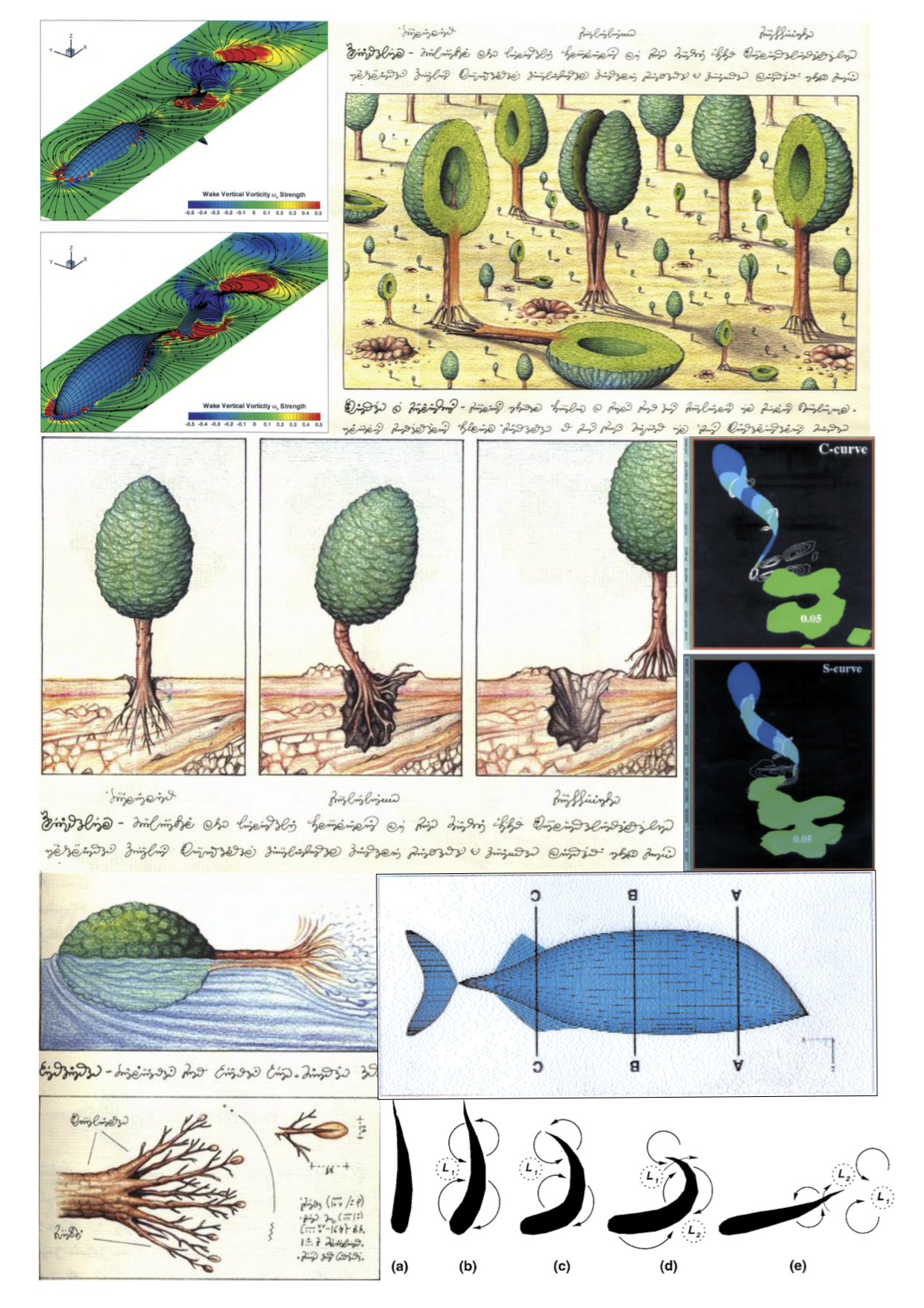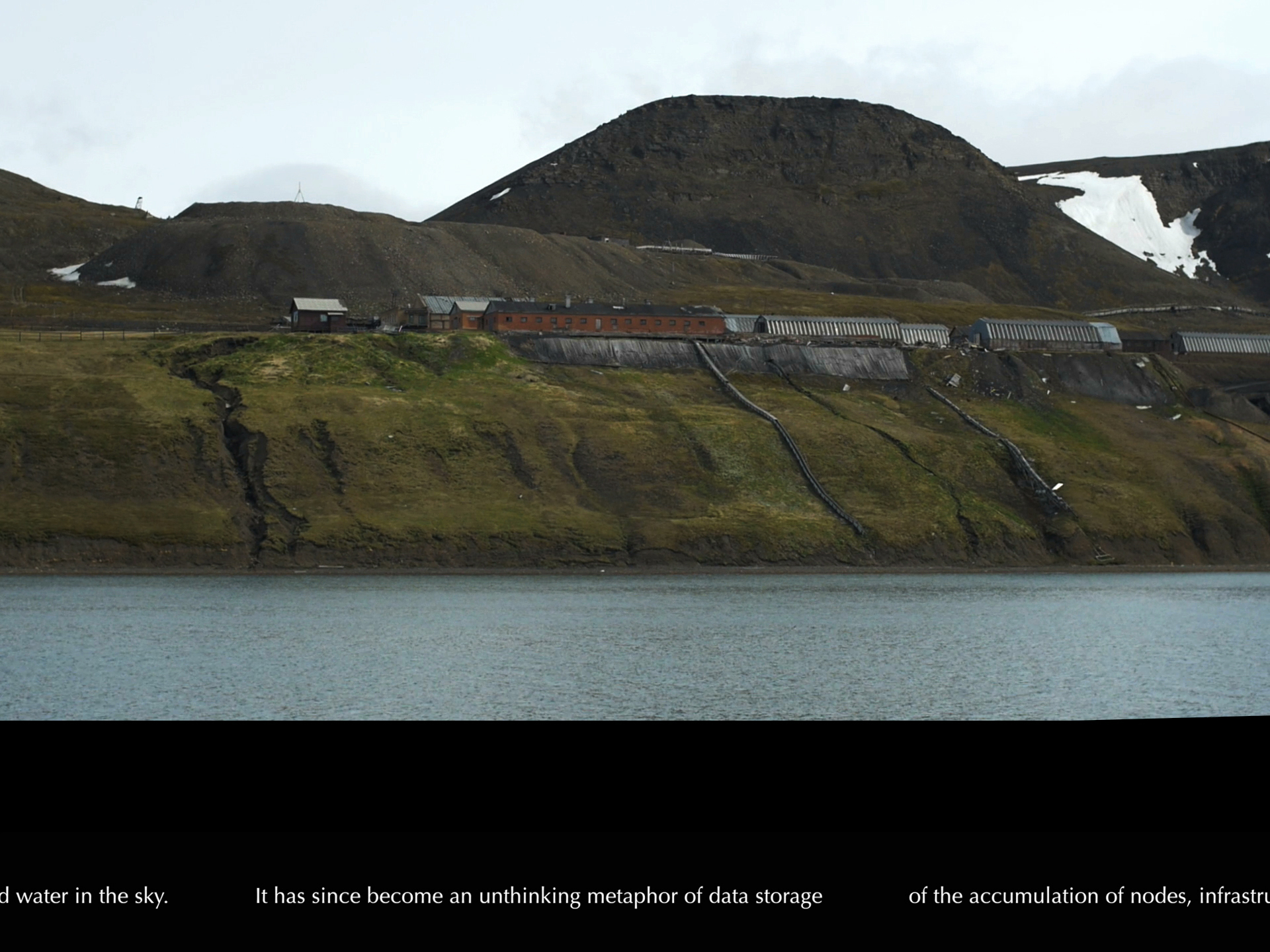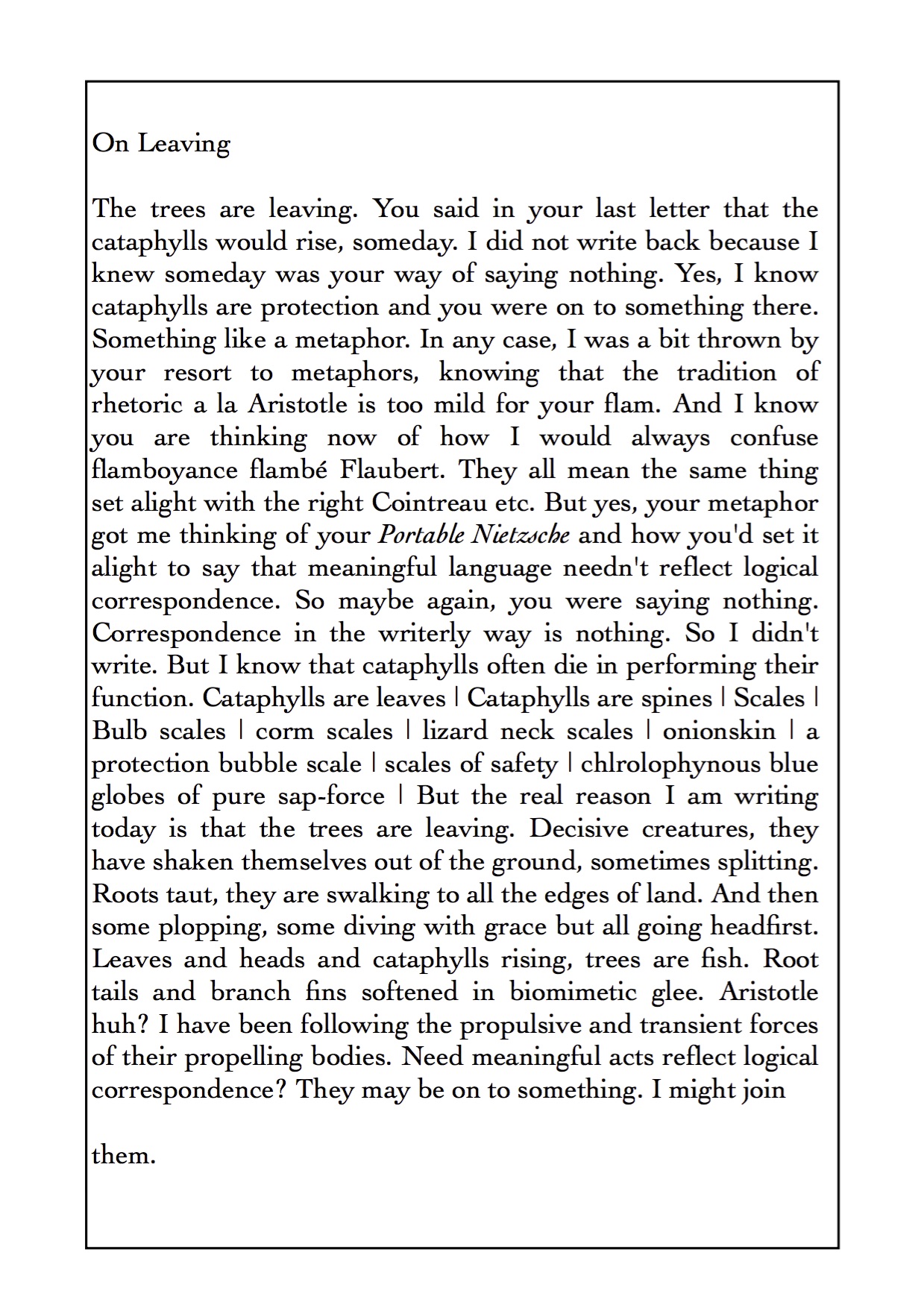Although the seminars of “Anthropocene Campus: The Technosphere Issue” at Haus der Kulturen der Welt (HKW) in Berlin took place months ago (April 14–22, 2016), conversations and collaborations continue to develop and spill out from that place and time. This process of unfolding is a particularly important outcome of the original nine-day conference because it invites collaborators to explore Anthropocene topics with one another, on their own terms, and in locations around the world. Sria Chatterjee and Hanna Husberg are currently engrossed in that process, sharing the resources and insights of their respective fields to address the question of rights and accessibility.
In addition to being a published poet, Sria Chatterjee is a PhD candidate in the Department of Art and Archeology at Princeton. Her research is focused on modern India and questions around art, activism, and ecology. Hanna Husberg is a visual artist inquiring into how humans perceive and relate to their immediate and extended surroundings in times characterized by human-induced climate change. Currently on a fellowship in China, Husberg is pursuing a PhD in practice at the Academy of Fine Arts Vienna. Together they question the idea of access, drawing connections between theoretical and physical rights to our shared place, Earth.
Caroline Picard: Could you speak a bit about your experiences at the HKW’s “Anthropocene Campus” this past April? How did it influence your work?
Hanna Husberg: I was particularly touched by the generosity of the people organizing and participating in the program. The campus was, however, an exceptional space that is only possible to maintain for a certain amount of time before everyone needs to get back to everyday obligations. A question many of us were left with was how to take this further, keep this energy going, and productively make use of all the experiences and the possibilities that one could feel were in those rooms.
We all have distinctive means of making sense of the world we live in, and with major shifts concerning the livability of the planet, it is important to use different means of disseminating information. Sria and I have a shared background in the arts, but we also have contrasting experiences and practices that might be complementary and could strengthen our individual practices.
Sria Chatterjee: While my academic work focuses on the relationships between art, politics, and ecology in India and looks at perceptions of nature and systems of knowledge in a historical and historiographical context, the urgency of rethinking ways of naming, knowing, and being in the contemporary planetary crises that Hanna just mentioned has been pushing my creative and curatorial interests as well.
CP: I understand, Sria, that you’re working on a poetry manuscript that addresses “the borderlands between human and nonhuman consciousness.” How do poetry and academic language provide different points of access to thought and experience?
SC: The manuscript that you mention plays with the surreal nature of the contemporary environmental crisis and its broader politics with imagined objects and processes. “Behind every real object,” Baudrillard writes, “there is a dream object.”1 Turning that around, I am interested in the fluid relations between dream logic and the logic of late capitalism (which in Frederic Jameson’s iteration suggests that every position on postmodernism today is necessarily, explicitly or implicitly, a political stance on multinational capitalism). What I particularly value about making poems is the recklessness that it can afford, one in which I can experiment with images, language, sensibilities, and perceptive capacities both human and imagined. My hope is to challenge existing epistemologies and asymmetrical power relations as much as to harness a deep self-doubt about the primacy of human perception that might present a reader with sets of dilemmas about what goes on around and inside us.
CP: Does that dovetail with your work together?
SC: In our collaboration, which is still very new since it grew out of the HKW campus, the idea is to work as an artist-curator team in which the roles are reversible and contingent on each other. In bringing our interests together, one of the things that became relevant for us is the idea of artistic research and the potency of field-based research, artistic practice, and speculative experiments that can open up to explore questions about the governmentality (the methods of control or governance) of addressing climate change, which are also central concerns in Hanna’s work.
HH: For some time, I have been developing an artistic research project, Troubled Atmosphere. It focuses on the materiality, relevance, and effect of air and considers our possible and impossible relationships to our environment in a time characterized by human-induced climate change.
CP: I read about that project on Hybrid Matters: you examine how new human-made gases and chemicals are released into the atmosphere, but the emphasis is on air, or atmosphere, rather than material objects.
HH: Well, air is literally what is closest at hand. Air is both inside and outside of us, constantly. It is disrespectful of borders. It enters the pores of (what has been regarded as) distinct bodies. It blurs the boundaries between subjects and environments and even those within subjects. Air is evasive and can multiply. Although it surrounds and pervades all, the air of one location is unlike that of another. It is essentially an aggregate and a carrier, and it is composed of different elements even as it is coproduced and shared.
CP: It reminds me of something Lisa Blackman once wrote about the hierarchy of senses: culturally, we tend to privilege sight over the other senses, especially smell, which is perceived as more vulgar. In her book, The Body: Key Concepts, she suggests this is partly because we don’t have any control over whether or not smells enter our bodies.
HH: Air is extremely familiar yet difficult to grasp, and as such I find it helpful in thinking about climate. The invisibility of air has also brought me to inquire into questions of perceptibility, of how things seem to come into existence, and the tools and instruments that have come to structure our apprehension of the environment.
CP: How does that come across in your work?
HH: My research is developed through different projects that are structured through specific case studies, like the Maldives and Svalbard, for example. While these are geographically distant locations, they are connected through the events of climate change. I am also spending some time in Beijing this fall. These locations have been useful for me to situate the research and to apprehend the slow violence that is implicit in the compositional changes of the atmosphere.
CP: I’m curious about the result of your research and what it lends to art. Maybe another way of asking that same question is: how do you differentiate between research and art?
HH: Well, following the PhD curriculum, I’m currently engaged in artistic research based on the premise that art can be understood as “a space for social, political, cultural, and economic conflicts, in which claims of knowledge as much as truth are negotiated.” The production of artistic knowledge becomes a subject matter of research. Basically it pushes you to critically reflect and actively shape your position as a producer or mediator of knowledge. Artistic research encourages experimental modes of artistic production that reconfigure established disciplines of knowledge. In this sense, it can also be understood as a process of negotiating boundaries. In practice, it has pushed me to convene with researchers across different disciplines and to address questions I wouldn’t have been able to otherwise. It has also included sharing and learning from and with each other.
CP: The structure of the HKW “Anthropocene Campus” seems to encourage integrated thinking, to urge research and practice to overlap among experts working in different fields.
HH: I think one of the goals of the campus was to encourage us to go further in our work by joining forces. There’s no need to repeatedly start from scratch, but we can build upon what we have. I shared a recent work with Sria at the campus: a film, set in the former no-man’s-land of Svalbard, that takes the region’s cloudiness as a point of departure to reflect on some of the material exchanges taking place through the atmosphere. It pointed at some of the transmissions and transformations of clouds—physical, biological, chemical, digital. That film started our ongoing discussion on migration and mutability.
SC: Regarding the potential of artistic and academic research, the notion of access is something that we have been thinking about a lot. How, for instance, can we creatively and constructively think about the politics of access? Taking the relational nature of access seriously, might we reinterpret access along a triple junction—using a term from geology, for the point where the boundaries of three tectonic plates meet—in which the three elements are: open access, access to land/water/air rights, and access as an outburst?
CP: I tend to think of access as a theme connected to cultural rights: for instance, who can use the Mickey Mouse icon, or how is knowledge disseminated through academic papers? Of course there is the idea of physical access—of trespassing on land, or having rights to water—but I like thinking of material and theoretical realms as equivalent.
SC: The use of the metaphor of the triple junction is deliberate. It points to the enmeshed quality of human and nonhuman life—of biology, geology, technology, capital, and so on. The paradox of open-access research is deeply embedded in larger access issues, such as how geographically-based rights pertain to natural resources (for instance, can animals and forests have rights too?). While this brings up the question of epistemological diversity (something Zoe Todd writes about very effectively), ontological possibilities, and projected realities, the use of access as an outburst introduces the element of affect. What are the aesthetics of the new ways in which we seek to know and imagine in the sphere of technology, or the Capitalocene (coined by Jason W. Moore), or Eurocene (coined by Jedediah Purdy)? It is also useful to ask what stakes are presented by these categories and why we should take them seriously. Deborah Bird Rose (in Anthropocene Noir) writes about how our sensorial systems are being refashioned. The access debate, by virtue of the current predicament of the planet, must make space for reorientations not only in the way we know but also in the way we perceive.
But access raises other issues, too. Who has access to the future? Can we work toward common critical values?
HH: We are both interested in a being of the world, a coexistence that involves humans as well as a myriad of more-than-human entities and agencies. However, this is not a leveling of all beings and things. It requires caution and demands from us an acknowledgement of the structural violence that has historically excluded some people to be considered human in the first place.
SC: While the Anthropocene is a useful umbrella to address questions of human agency, as a category it can also be a slightly problematic tool for whitewashing the vast inequalities that arise once we take apart the anthropic: race, gender, capital, class, caste, and so on. All of these inequalities are tied to geographical locations, nations, and institutions. One of the challenges in thinking beyond the human, in focusing on climate change, is that it can homogenize the complex and uneven structures of power, consumption, and possibilities of survival that are set in motion by our current planetary, and perhaps extra-planetary, conditions. How can we address these questions in the space of an artwork, gallery, or essay?
CP: That seems to raise exciting questions about the space of an artwork, gallery, or essay and what kinds of hierarchical patterns might be linked to the formal demands of each context.

Sria Chatterjee. On Leaving, 2016. Manuscript, second page (includes photos of a page from Luigi Serafini’s Codex Serafinianus). Courtesy of the artist.
HH: One question we have been discussing is the governmentality concerning the air and climate change. We are all immersed in air, but we are so in very different ways. So we started thinking about the aesthetics of governmentality regarding climate change—about the role of maps, climate models, satellite images, imaging technologies, and information systems in shaping scientific inquiry, legal legislation, political decision-making and, ultimately, a renewed environment.
I also recently came across a relevant text by the feminist scholars Neimanis, Åsberg, and Hayes that discusses post-humanist imaginaries. They notably stress that imaginaries are not what we have but what we do. And as an imaginary is “the explorative, yet sense-making field wherein humans cultivate and negotiate relations with the material world, both emotionally and rationally, while also creating identities for themselves,” it also provides opportunities to reimagine our relationship to what we define as nature. In this way imaginations can be considered part of governance, that is, the organized practices—mentalities, rationalities, and techniques—enabling material interventions in the world and the means through which political sensibilities are created. This is an important reminder of agency and of the roles that aesthetic narratives and imaginaries have in shaping the world.
SC: One of the ways in which we describe the artistic interventions is “Art as Asymptotic Analysis.” Asymptotic analysis at its simplest iteration allows for approximation. Artworks that deal with the climate crisis and provoke new ways of seeing and being can be thought of as conjectural, approximate, and speculative; this approach allows a slippage between a firm quantified number and a range of possibilities. In creating propositions or what we call “Candidate Theories for a Slippery Planet,” the aim is to provoke tensions within established regimes of knowledge, the entangled nature of capital, technology, the natural sciences, and lived experience.
CP: Can you say a bit more about what your collaboration will result in? You said you wanted to swap roles as curator and artist. What does that mean? And what will you make together?
HH: We are still at the beginning of our collaboration, so rather than an end, we envisage a lot of possibilities. I’m just starting a residency at the Institute for Provocation in Beijing and am hoping to find a context in which we can collaborate once I get back to Europe, possibly the Frontiers in Retreat. Our discussions have revolved around migration, mutability, governmentality, and access. These are broad questions and will evolve into a few different projects.
1. Jean Baudrillard, The System of Objects (London: Verso, 2005), 126.





